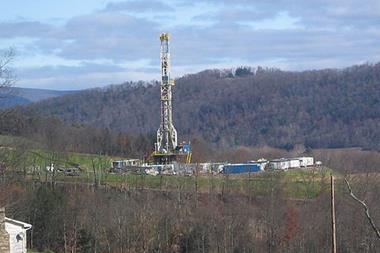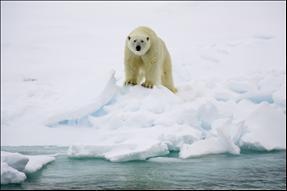Using pioneering ice-drilling methods, one survey team has made the most ominous predictions yet for the future of the polar caps. Nathan Skinner looks at the perils facing the Arctic – and those who explore it
There can be few places on earth less hospitable than the Arctic: a vast ice-covered ocean stretching up from the northern tip of Canada and bordering Greenland, Russia and Scandinavia. Temperatures in the winter average -40C. Freezing high-speed winds often push this down a further 20C and stir up vicious snowstorms. Travelling across this white wilderness is not for the faint-hearted. As well as playing host to polar bears, the floating ice crust is prone to fracture, as it is constantly moving, opening up great expanses of icy water as it does. Giant snow and ice pressure ridges also form when separate ice flows collide with each other. All this makes the frozen expanses of the Arctic particularly hazardous.
The Arctic is also an extremely sensitive ecosystem. Scientists believe a temperature rise of just a couple of degrees could have already tipped its delicate equilibrium, causing irreversible damage. The speed at which Arctic sea ice is melting is a frightening example of the impact climate change has already had on the earth’s natural environment. Models can vary hugely but it is now widely accepted that over the past 30 years around 40% of the Arctic summer ice has permanently disappeared: an area the size of the USA. The vast majority of models predict that the region will be completely ice free before the end of this century.
One of the most recent and most dire predictions comes courtesy of the Catlin Arctic Survey team. On 1 March this year, veteran polar explorer Pen Hadow was joined by colleagues Martin Hartley and Ann Daniels as they embarked on what would become a 450km trek to the North Pole across the frozen Beaufort sea, off the north coast of Canada and Greenland (See map). During their epic 73-day exploration, the team used manual drilling to measure the thickness of the sea ice. It was the first time a survey had captured surface ice measurements in this way; previously all data was gathered using satellite images or submarine radar measurements from beneath the surface.
The Survey smashed existing perceptions about the thickness and age of the ice in this area – something that had not been probed by anyone else. Even the most up-to-date models were based on the assumption that this area held multi-year ice thick enough to survive at least one year’s summer melt. Shockingly, the team discovered that practically all of the ice they encountered was first year; in other words, it had frozen the previous winter and would retreat again in the summer. The models that formed the basis of most predictions of Arctic ice melt were being fed the wrong information, according to the Survey. This evidence will be taken to the UN Climate Change Conference in Copenhagen in December 2009.
The findings have rocked the scientific community. According to the Catlin team, the Intergovernmental Panel on Climate Change (IPCC) Fourth Assessment Report – which originally predicted that most of the Arctic sea ice would be gone somewhere between 2070 and 2100 – is wildly off the mark. When the data was analysed by leading climate scientists at Cambridge University, their prediction was that almost all the Arctic sea would be ice free during the summer within a decade.
If this turns out to be the case, it would have a number of dramatic consequences for the planet. For one, an ice-free Arctic Ocean would be open to commercial exploitation. Arctic states have begun to stake their claims on the many resources hidden beneath the frozen ocean. Recent US Geological Survey predictions say the Arctic could be home to a third of the world’s undiscovered natural gas and 13% of its undiscovered oil.
Furthermore, for hundreds of years sailors and explorers have ventured into the treacherous region in hope of finding the legendary Northwest Passage, a navigable sea route connecting the North Atlantic and Pacific Oceans. Up until very recently the passage, which is the most direct shipping lane from Europe to Asia, has been ice bound throughout the year, making it virtually impassable.
This year, however, was the third year in a row that the route was open to ships without the need of an icebreaker and in September, two German ships became the first commercial vessels to make the voyage. The thinning sea ice is therefore welcome news for commercial shipping companies looking for a short cut around the world.
The warming of the North Pole is also likely to have a big impact elsewhere. The degree of difference in temperature between the Arctic and equatorial regions is one of the principal factors governing weather patterns in the Northern Hemisphere. Even small changes to this ratio could have wide-ranging and catastrophic implications for people living in this part of the world.
Martin Sommerkorn from the WWF International Arctic Programme, which partnered with the Survey, explains: “The Arctic sea ice holds a central position in our Earth’s climate system. Take it out of the equation and we are left with a dramatically warmer world.”
The WWF researched the impact of the loss of Arctic sea ice cover in terms of amplifying and accelerating the consequences of global warming. “This could lead to flooding affecting one-quarter of the world’s population, substantial increases in greenhouse gas emissions from massive carbon pools and extreme global weather changes," Sommerkorn says.
The expedition
Once he was safely back on home soil, Hadow took the opportunity to speak to StrategicRISK about his pioneering expedition, what he has learnt about the vulnerable Arctic environment and the risks his team encountered along the way.
“The main objective of the expedition was to advance scientific understanding of the future status of the sea ice cover on the Arctic Ocean,” he explains. “A subsidiary objective was to engage a global audience to better understand the environment of the Arctic Ocean, the changes that are taking place and what the consequences are for people around the world, especially in the Northern Hemisphere.”
Hadow was both shocked and disconcerted by the conditions his team confronted in the Arctic. “We had been led to believe that we could expect a good proportion of the sea ice to be older, thicker, multi-year ice. But what we found was virtually no multi-year ice, only first-year ice.”
Any scientific expedition of this magnitude is rarely free from problems, and the Catlin Arctic Survey proved no exception. “Not everything went according to plan,” Hadow recalls. His team’s safe return, however, attests to his considerable skill and experience as a polar explorer. In 2003, Hadow shot to fame as the first person to single-handedly trek unsupported from Canada to the North Pole – a feat not since repeated by anyone.
Over the course of the expedition, Hadow and his team were confronted with exceptionally cold conditions – sometimes reaching as low as -75C taking into account wind chill, disintegrating ice flows that they had to jump between like frogs on lily-pads, problems with their equipment, as well as all the everyday risks of surviving for three months in the Arctic. They even came across two pairs of polar bear tracks, one set of which they believed to be an adult male. But with over two decades of experience exploring both poles, Hadow’s achievements speak for themselves.
“With the right experience, you can control the risks,” he says. “Explorers are peculiarly good at managing risks. That is one of their defining attributes. They are good at identifying risks, assessing them, avoiding them if at all possible, and managing those that have to be managed. That’s what brings explorers back from places where others wouldn’t even think to go.”
To begin with, progress across the ice was slower than the team had hoped. This meant they could only complete about half of the distance they had originally intended to cover (around 1,000km). This slow pace was down to a number of factors.
As no one had ever been to the northern Beaufort Sea and done a surface survey before, it was hard for the team to know what to expect. As it turned out in the extreme conditions manually drilling down into the ice proved to be very hard work and time-consuming. “It was very slow progress and we weren’t able to drill as many holes as we would have liked,” Hadow concedes. They were only able to survey 32 sites across the entire 450km route.
Another factor that slowed the team down was the lack of consistent sea ice cover. As the ice thins it becomes more prone to fracturing. On a number of occasions, the three explorers were forced to resort to the “amphibious option” – donning immersion suits and swimming part of their journey. The team even had to abandon their camp one night when the ice flow they were sleeping on started to disintegrate.
The biggest frustration for the team was the fact that one of their measuring devices did not work. The team planned to tow a portable radar with them to measure the ice thickness every few centimetres. Had it worked, the device would have provided huge amounts of digital information. But it didn’t work in the extreme cold – despite passing rigorous pre-expedition checks. This drastically reduced the amount of data the team was able to gather. Instead they were forced to rely on their manual drilling and visual surveys.
These problems have led some to criticise the scientific value of the team’s work. A number of websites have sprung up with the explicit purpose of discrediting the Survey. However, there are suggestions that these bloggers are backed by industrial forces that have a vested interest in denying the effects of climate change.
Professor Peter Wadhams, who leads a research programme at Cambridge University on the state of sea ice cover in the North Pole, verified the validity of the team’s observation techniques and the quality of its research, although he does describe the manual drilling method and surface ridge observations as a “rough and ready approach”. Wadhams comments: “Even though it was not the world’s greatest method, it did give valid results. We analysed the volume of the data and found that it agreed pretty well with the data received from a submarine underneath the same ice.”
Hadow acknowledges that the Catlin Arctic Survey has not provided absolute proof of the lifespan of the Arctic sea ice, although the evidence for its disappearance is compelling. He accepts that further research needs to be done. “A number of lessons have been learnt about what is realistically achievable. No observation technique is perfect, but we’ve enabled a new type of observation to be conducted by other explorers in the future. And, together with other research, we have created a more comprehensive picture of what’s going on in the Arctic.” Asked about the possibility of more expeditions in the future, Hadow says a return journey is a serious possibility. “We would like to go back and put the radar through its paces.”
Global implications
The loss of Arctic sea ice is thought to set in motion powerful feedback loops, amplifying the process of global warming and melting poles. Traditionally, Arctic sea ice has reflected the majority of solar radiation back up into the atmosphere. Darker, ice-free, ocean or bare land has the opposite effect, absorbing more heat. Studies show the Arctic is losing 4% of its snow cover a decade, while the ice is diminishing even faster, at a rate of more than 11% a decade. Less ice means a warmer sea, and a warmer sea means less ice.
In turn, the warming cycle in the Arctic influences weather patterns, particularly in the Northern Hemisphere, by changing wind and water currents. The global weather is driven by the differences in air temperature between tropical regions and the poles, which in turn affects atmospheric circulations. Observers in Europe are already monitoring a trend towards drier winters in Scandinavia and wetter ones in the Mediterranean. The US stands to see drier winters too, according to the same hypothesis. A warming Arctic could also create more unpredictable and extreme weather events, including a higher risk of fire in the western USA.
Thawing permafrost is another of the sweeping changes being observed in the Arctic. Amplified atmospheric warming in the Arctic will likely hasten the degradation of permafrost, leading to increased release of greenhouse gases presently locked in frozen soils, leading to further arctic and global warming, according to the WWF’s Arctic Climate Feedbacks [ital] report.
“The projections for permafrost are dire,” Sommerkorn says. Around 90% of near-surface permafrost is expected to have thawed by 2100. The permafrost soils in the Arctic store around twice as much carbon as that which is currently held in the atmosphere. Large amounts of methane, a powerful greenhouse gas, is also found in permafrost. When the permafrost thaws, the soil starts emitting carbon dioxide (CO2) and methane, contributing to the flywheel global warming effect.
More carbon in the atmosphere also increases ocean acidification. Part of the CO2 in the air dissolves in water, making it more acidic. This can make life very hard for marine organisms, particularly those that rely on calcium carbonate shells. Arctic species are also not well-equipped to deal with warmer waters. This is unfortunate, as the Arctic is currently home to most of Northern Europe’s most productive fishing grounds.
Additional quantities of fresh water flowing into the Arctic, caused by melting snow and ice, is being watched with great concern by scientists. They are worried that the pattern of currents could be altered, particularly in the North Atlantic. The Gulf Stream, which dictates much of Europe’s weather, could be reduced by as much as 25% by the end of the century, according to the IPCC.
Although melting Arctic sea ice does not itself have a direct impact on sea-level rise – it does contribute indirectly. “There may be a link between warm waters in the Arctic and increased melting of the Greenland ice sheet,” Sommerkorn notes. The rate that the Greenland ice sheet, which is basically a giant glacier, is melting has nearly tripled over the last 15 years. Most of this increased melting is caused by warmer water from the Arctic hitting the west coast of the ice sheet.
Sommerkorn believes the IPCC should revise its projections of global sea-level rise upwards to take this into account. He says the IPCC excluded the contributions from ice sheets in their projections of sea level rise because they were not accurately understood. “If the contributions of the ice sheets are included, global sea-level rise projections would be well over one metre by the year 2100.” This compared with the existing official projection of around 50cm.
Global sea-level rise would have a devastating impact on the lives of millions of people worldwide. Most of the Maldives islands are no more than a metre above sea level; their 360,000 inhabitants could be forced to evacuate in the next 50 years or so. Further, cities such as London, Bangkok, Alexandria and New York could also end up below sea-level if adequate flood protection measures are not put in place, displacing millions and causing vast economic damage.
The opening of commercial sea routes and mining of resources from the Arctic is only likely to exacerbate the region’s problems. An international power struggle is underway as governments rush to stake their claims to the large oil, gas and mineral deposits in the Arctic. Russia has tried to claim 50% of the sea bed area, having planted a rust-proof titanium flag on the ocean floor. Many other Arctic states have increased their military or strategic presence in the region. “We need a lot of international approaches and a new governance regime to control and steer some of these economic developments on a pan-Arctic scale rather than on a scale of national interests,” Sommerkorn comments.
The earth’s climate is an incredible complex interconnected system, which is one reason why predicting the impact of global warming is so difficult. What’s becoming increasingly clear is that global warming presents a dangerous feedback loop. “We are facing a real phase change in the Arctic Ocean over the next 100 years should we leave global climate change unabated,” Sommerkorn stresses. “We have to limit warming to a degree that averts the snowball effect.”
Wadhams adds: “I don’t think we can turn around the disappearance of the Arctic summer ice now. The thing that can be turned around is the disappearance of the Arctic winter ice, which is predicted to happen sometime in the near future.”
Current levels of Arctic sea ice loss are the result of a global temperature rise of just 1C since pre-industrial times. This is currently committed to a further rise of 1.4C as a result of the levels of carbon currently in the atmosphere, according to the IPCC scientists.
Prior to the onset of the economic crisis, the world was on target for a worst-case emissions scenario, which predicted a 4.8C rise in global temperatures by the end of the century. In order to avoid this scenario, world carbon emissions need to peak before 2020 and fall in the region of 6% a year after that. Fortunately, a number of countries are committed to securing a radical global agreement on emissions reduction at the UN Climate Change Summit in Copenhagen. The corporate sector has a vital role to play in reducing global emissions. The stakes could not be higher.
Postscript
Nathan Skinner is associate editor of StrategicRISK



















